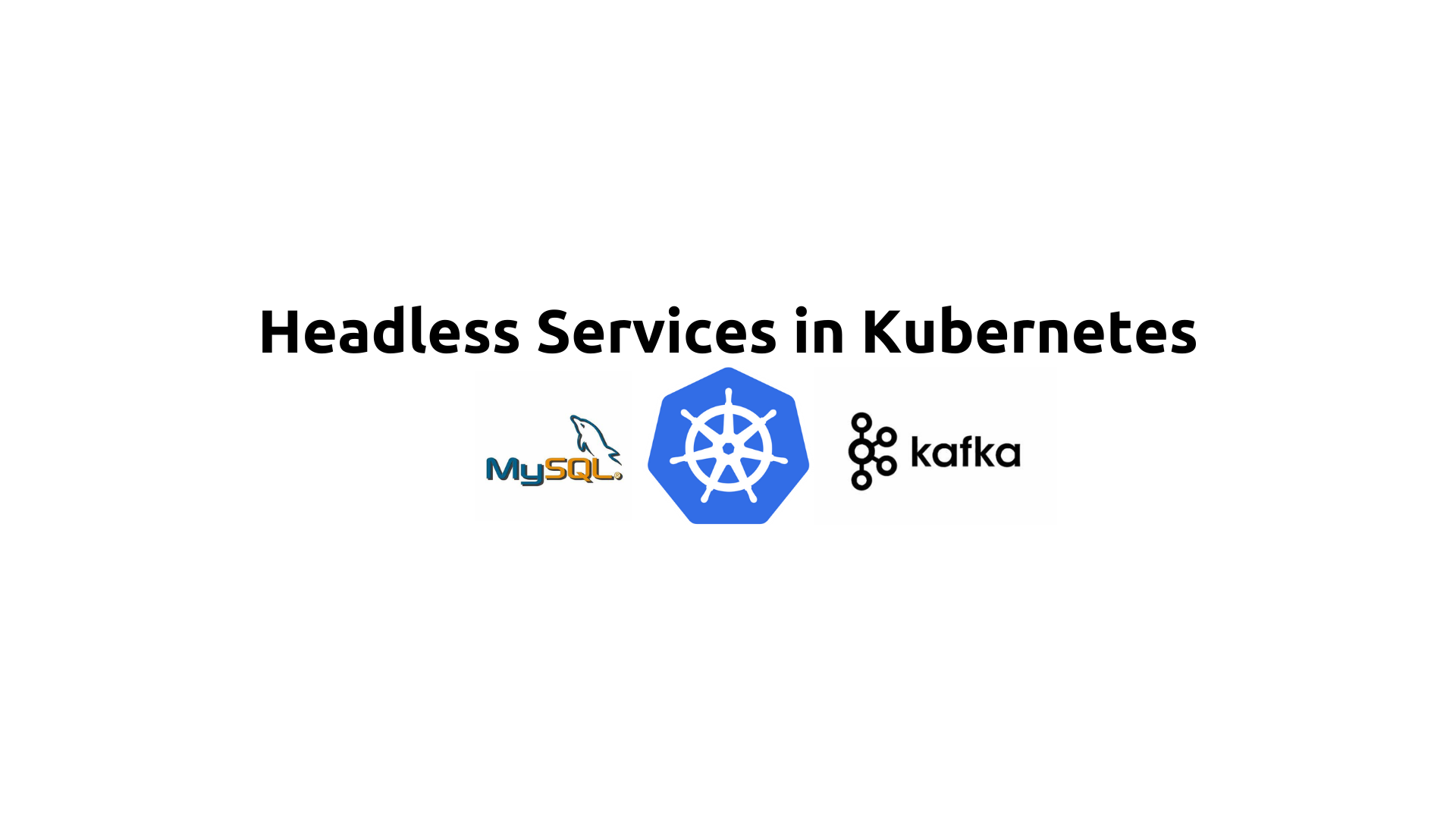Headless Services in Kubernetes
 Saurabh Adhau
Saurabh Adhau
Introduction
Kubernetes, a powerful container orchestration platform, provides several types of services to expose and manage applications running in pods. One such service type is the Headless Service, which is particularly useful for stateful applications and certain networking scenarios. This article will explore what Headless Services are, their benefits, and scenarios in which they are useful, and provide practical examples.
What is a Headless Service?
A Headless Service in Kubernetes is a type of service that does not assign an IP address to itself. Instead of acting as a load balancer, it allows direct access to the individual pods behind the service. This is achieved by setting the clusterIP field to None in the service specification.
Key Characteristics of Headless Services
No Cluster IP: Unlike regular services, Headless Services do not have a cluster IP.
DNS Records: They create DNS records for each pod, allowing direct access to pods via their individual DNS names.
Stable Network Identity: Useful for stateful applications that require stable network identities.
Pros of Headless Services
Direct Pod Access: Provides direct access to individual pods, which is essential for stateful applications that need to communicate with specific instances.
Service Discovery: Simplifies service discovery for applications like databases or distributed systems.
Persistence: Ensures stable network identities, which is crucial for stateful workloads.
Scenarios for Using Headless Services
Headless Services are ideal for scenarios where direct access to pods is required, such as:
Stateful Applications: Databases (e.g., MySQL, PostgreSQL), distributed storage systems (e.g., Cassandra, HDFS).
Service Discovery: Applications needing direct access to pod IPs for intra-cluster communication.
Load Balancers: External load balancers that need to access specific pod instances.
Examples of Headless Services
Example 1: Headless Service for a MySQL StatefulSet
Step 1: Create a Headless Service
Define a Headless Service for a MySQL StatefulSet.
apiVersion: v1
kind: Service
metadata:
name: mysql
spec:
ports:
- port: 3306
clusterIP: None
selector:
app: mysql
Create the service using:
kubectl apply -f mysql-headless-service.yaml
Step 2: Create a StatefulSet
Define the StatefulSet to deploy a MySQL cluster.
apiVersion: apps/v1
kind: StatefulSet
metadata:
name: mysql
spec:
serviceName: "mysql"
replicas: 3
selector:
matchLabels:
app: mysql
template:
metadata:
labels:
app: mysql
spec:
containers:
- name: mysql
image: mysql:5.7
ports:
- containerPort: 3306
env:
- name: MYSQL_ROOT_PASSWORD
value: "rootpassword"
volumeMounts:
- name: mysql-persistent-storage
mountPath: /var/lib/mysql
volumeClaimTemplates:
- metadata:
name: mysql-persistent-storage
spec:
accessModes: [ "ReadWriteOnce" ]
resources:
requests:
storage: 1Gi
Apply the StatefulSet configuration using:
kubectl apply -f mysql-statefulset.yaml
Example 2: Headless Service for a Kafka StatefulSet
Step 1: Create a Headless Service
Define a Headless Service for a Kafka StatefulSet.
apiVersion: v1
kind: Service
metadata:
name: kafka
spec:
ports:
- port: 9092
clusterIP: None
selector:
app: kafka
Create the service using:
kubectl apply -f kafka-headless-service.yaml
Step 2: Create a StatefulSet
Define the StatefulSet to deploy a Kafka cluster.
apiVersion: apps/v1
kind: StatefulSet
metadata:
name: kafka
spec:
serviceName: "kafka"
replicas: 3
selector:
matchLabels:
app: kafka
template:
metadata:
labels:
app: kafka
spec:
containers:
- name: kafka
image: wurstmeister/kafka:2.13-2.6.0
ports:
- containerPort: 9092
env:
- name: KAFKA_BROKER_ID
valueFrom:
fieldRef:
fieldPath: metadata.name
- name: KAFKA_ZOOKEEPER_CONNECT
value: zookeeper:2181
volumeMounts:
- name: kafka-persistent-storage
mountPath: /kafka
volumeClaimTemplates:
- metadata:
name: kafka-persistent-storage
spec:
accessModes: [ "ReadWriteOnce" ]
resources:
requests:
storage: 1Gi
Apply the StatefulSet configuration using:
kubectl apply -f kafka-statefulset.yaml
Example 3: Headless Service for a Cassandra StatefulSet
Step 1: Create a Headless Service
Define a Headless Service for a Cassandra StatefulSet.
apiVersion: v1
kind: Service
metadata:
name: cassandra
spec:
ports:
- port: 9042
clusterIP: None
selector:
app: cassandra
Create the service using:
kubectl apply -f cassandra-headless-service.yaml
Step 2: Create a StatefulSet
Define the StatefulSet to deploy a Cassandra cluster.
apiVersion: apps/v1
kind: StatefulSet
metadata:
name: cassandra
spec:
serviceName: "cassandra"
replicas: 3
selector:
matchLabels:
app: cassandra
template:
metadata:
labels:
app: cassandra
spec:
containers:
- name: cassandra
image: cassandra:3.11
ports:
- containerPort: 9042
volumeMounts:
- name: cassandra-persistent-storage
mountPath: /var/lib/cassandra
volumeClaimTemplates:
- metadata:
name: cassandra-persistent-storage
spec:
accessModes: [ "ReadWriteOnce" ]
resources:
requests:
storage: 5Gi
Apply the StatefulSet configuration using:
kubectl apply -f cassandra-statefulset.yaml
Conclusion
Headless Services in Kubernetes provide a robust mechanism for managing stateful applications and scenarios requiring direct access to individual pods. By foregoing a cluster IP, Headless Services facilitates stable network identities and simplified service discovery, making them ideal for databases, distributed systems, and external load balancers. The practical examples provided demonstrate how to deploy MySQL, Kafka, and Cassandra clusters using Headless Services, highlighting their ease of use and effectiveness in managing stateful workloads. Understanding and leveraging Headless Services can significantly enhance the reliability and scalability of your Kubernetes deployments.
Subscribe to my newsletter
Read articles from Saurabh Adhau directly inside your inbox. Subscribe to the newsletter, and don't miss out.
Written by

Saurabh Adhau
Saurabh Adhau
As a DevOps Engineer, I thrive in the cloud and command a vast arsenal of tools and technologies: ☁️ AWS and Azure Cloud: Where the sky is the limit, I ensure applications soar. 🔨 DevOps Toolbelt: Git, GitHub, GitLab – I master them all for smooth development workflows. 🧱 Infrastructure as Code: Terraform and Ansible sculpt infrastructure like a masterpiece. 🐳 Containerization: With Docker, I package applications for effortless deployment. 🚀 Orchestration: Kubernetes conducts my application symphonies. 🌐 Web Servers: Nginx and Apache, my trusted gatekeepers of the web.